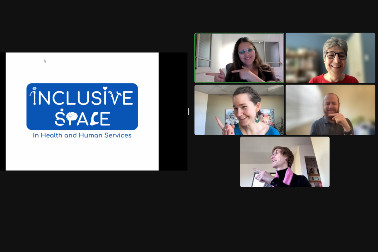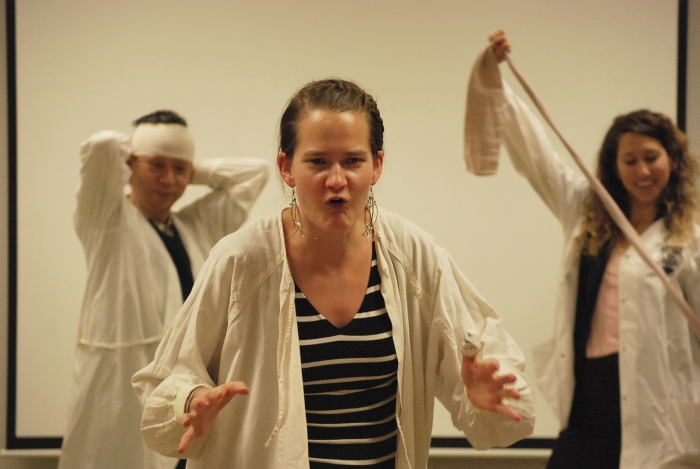
Congratulations are in order for the Alone in the Ring team, who recently received the 2022 D2L Innovation Award from the Society for Teaching and Learning in Higher Education (STLHE).
Find out more about this fascinating project and how it offers an innovative approach to teaching, learning, empathy and activism.
Alone in the Ring, the award-winning, research-based theatre project
Healthcare students and clinicians with disabilities face unique challenges.
A team of UBC RbT cluster researchers, professionals, students, and community members created the play Alone in the Ring to understand the barriers and resources in the professional lives of people living with disabilities who work in Canadian healthcare settings.
Based on rich stories gathered through a three-year study, the play offers audiences insight into the lived experience of people living with disabilities, while asking audience members to consider how they can contribute to changing attitudes and increasing allyship within the health professions.
Hear more about the research-based theatre (RbT) approach and why it is so effective as a teaching tool.
Innovation and collaboration in action
“When I was a department head a few years back, I noticed an increase in the number of students living with disabilities in our program. But more striking to me was how difficult it was for us as a program to best support those students and ensure they graduated and started practicing as occupational therapists”
T Jarus, from the Alone in the Ring prologue
Research-based theatre seemed like the perfect pedagogical format for engaging students, faculty, professionals and broader audiences with the feedback and voices from Disabled professionals working in healthcare.
Fifty-six students and practitioners from three Canadian universities (across medicine, nursing, occupational therapy, physical therapy, and social work) were interviewed as part of the research, and a diverse team consisting of health professionals, theatre artists, researchers, educators, students, and people with lived experience of disability and other forms of marginalization collaborated on the play.
By promoting frank dialogue and reflection in a performance and interactive post-show discussion, Alone in the Ring challenges assumptions, and aims to build a nuanced understanding of the specific issues faced by Disabled persons working in health professions.
“As a student I started out thinking policy change was the way to go, but I realized that we can have all the ‘inclusive’ policies we want, but if peoples’ hearts don’t change to embrace difference we will never create a place where we can all belong”
L Y Bulk, alumna
Carefully-created scenes and memorable sequences use a mix of humour and conflict to reach not only the brain, but also the hearts of the audience, to inspire activism and promote the need for more inclusive learning and working environments, tackling themes of external and internalized stigma, disclosure, and the sense of belonging.
In a memorable final scene, a doctor engages in a metaphorical, musical boxing match with a personified version of the stigma they face.
The performance is then followed by a broad discussion between the project team and the audience, to reflect on the experiences shared in the performance and to empower audience members to be proactive about creating inclusive spaces in both their personal and professional lives.



How Alone in the Ring changed audience perceptions
“We need to listen for, validate, and uplift the experiences of clinicians with disabilities; our profession needs to be more diverse and inclusive. ‘What is YOUR role?’ This play made me reflect on times when I acted to perpetuate stigma/harm and times when I work to dismantle stigma.”
Professional development audience member
The play has now been performed to over 2,000 people. After each performance, the project team found a striking change in the attitudes and perceptions of students who had watched the play and the discussion.
Firstly, they found that students demonstrated a significant change in their attitude towards students and practitioners living with disabilities. Learners referred to how the play brought the topic ‘closer to home’, connecting with specific aspects of the performance on a personal and emotional level. Feedback indicates that making these connections has broadened their perspectives on the experiences of health and human service students and practitioners living with disabilities.
Secondly, students demonstrated a significant increase in their knowledge and understanding of the topic immediately after the show. Since many disabilities are invisible and disclosure of them does not always seem welcome, members of the audience who did not have disabilities were, in many cases, not even aware of the barriers to participation that persons living with disabilities face.
The two most significant shifts in student perspectives were:
- their increased awareness of the stigma that disabled people faced in health and human service education and professions, and
- in their motivation to take action
“After watching the play, I am struck by how little I knew about the barriers to entry for people with disabilities in healthcare fields. It made me reflect and I will go forward with more awareness.”
Student audience member
What’s next for Alone in the Ring?
Receiving the 2022 D2L Innovation Award is just one step along the continuing legacy of the project, which began in a first iteration in October 2018.

The team plans to continue to perform Alone in the Ring as both a pedagogical tool and as a tool for social justice, whether as part of academic workshops, as professional training or as community outreach. Additionally, the team is developing online learning modules based on Alone in the Ring, which will be widely accessible to instructors and organizations that want to engage in the discourse of accessibility in the health and human service professions.
If you would like to find out more about hosting a performance at your institution or workplace, please contact tal.jarus@ubc.ca
You can catch Alone in the Ring this summer at the inaugural World Occupational Science Conference (WOSC 2022), co-organized by UBC OSOT, which takes place on August 18-20 at the Sheraton Vancouver Wall Centre.
The Alone in the Ring Project Team
- Laura Yvonne Bulk (she/her), Accessibility Advisor, Centre for Accessibility; Clinical Assistant Professor, Occupational Science & Occupational Therapy; UBC.
- Christina Cook (she/they), PhD student, Counselling Psychology, UBC; Research Project Director, UBC Research-based Theatre Lab.
- Laen Avraham Dov Hershler (he/him), PhD student, Department of Language and Literacy, UBC.
- Yael Mayer (she/her), Senior Lecturer, Department of Counseling and Human Development, University of Haifa; Research Associate, Department of Occupational Science and Occupational Therapy, UBC.
- Tal Jarus (she/her), Professor, Department of Occupational Science & Occupational Therapy, UBC.